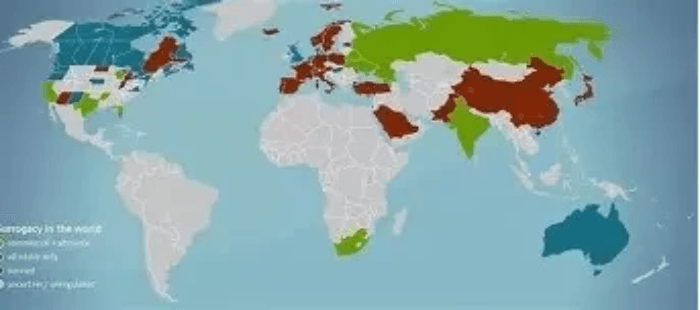The global surrogacy industry has evolved from a niche medical arrangement into a multi-billion-dollar international market with far-reaching economic implications. Once considered a last resort for infertile couples, surrogacy today represents not only a profound personal journey for intended parents but also a significant contributor to national economies, healthcare systems, and cross-border financial flows. As reproductive technologies advance and societal attitudes shift, the economic footprint of surrogacy is expanding across continents, reshaping labor markets, stimulating medical tourism, and prompting complex regulatory debates.
This article explores the multifaceted economic impact of the surrogacy industry worldwide, analyzing its contribution to GDP in key countries, employment generation, foreign exchange earnings, and regional development. We will examine case studies from leading surrogacy destinations, assess the ripple effects on related industries, and consider the ethical and policy challenges that influence economic sustainability.
1. The Global Surrogacy Market: Size, Scope, and Growth Trajectory
According to recent market research, the global surrogacy market was valued at approximately USD 15.3 billion in 2023 and is projected to grow at a compound annual growth rate (CAGR) of 9.6% through 2030, potentially exceeding USD 28 billion. This expansion is driven by rising infertility rates, delayed childbearing in developed nations, legal recognition in select jurisdictions, and the increasing affordability of assisted reproductive technologies (ART).

The United States remains the largest and most lucrative market, with surrogacy costs ranging from USD 100,000 to USD 180,000 per cycle. However, lower-cost destinations such as India (before its 2022 ban on commercial surrogacy for foreigners), Thailand (which later restricted access), and more recently, Georgia and Mexico, have attracted thousands of international intended parents annually, creating a robust medical tourism ecosystem.
Economic growth in this sector is not limited to direct medical services. Ancillary industries—including legal consulting, insurance, travel agencies, accommodation providers, and psychological counseling—have experienced parallel growth. For instance, specialized agencies now offer “surrogacy packages” that bundle IVF treatments, surrogate compensation, legal fees, and even postnatal care, mirroring the structure of high-end medical tourism offerings.
2. Employment Generation and Labor Market Dynamics
One of the most underreported economic benefits of the surrogacy industry is its role in job creation, particularly in developing economies where formal employment opportunities may be limited.
In countries like Nepal, Cambodia, and parts of Latin America, surrogacy has provided a source of dignified income for women from low-income backgrounds. While ethical concerns exist regarding exploitation, well-regulated programs can offer fair wages, health insurance, and financial literacy training. In Ukraine, prior to the war, an estimated 2,000–3,000 surrogacy cycles were performed annually, generating over USD 40 million in revenue and supporting thousands of jobs—from embryologists and nurses to legal assistants and coordinators.
Even in high-income countries, the industry sustains a specialized workforce. In the U.S., agencies employ case managers, matching specialists, financial planners, and legal experts dedicated solely to surrogacy logistics. Fertility clinics invest in cutting-edge laboratories and hire highly trained embryologists and reproductive endocrinologists, contributing to STEM employment and innovation.
Moreover, the demand for egg donors and gestational carriers has created a new category of compensated reproductive labor. While controversial, this form of work provides financial empowerment for many women, enabling them to pay off debts, fund education, or start small businesses. A 2022 study published in Reproductive BioMedicine & Society found that 78% of surrogates in regulated markets reported improved financial stability post-surrogacy.
However, the informal nature of surrogacy in unregulated markets poses risks. Without proper contracts, healthcare access, or legal recourse, some women face economic vulnerability. Thus, the long-term economic benefit hinges on establishing ethical frameworks that protect all stakeholders while maximizing inclusive growth.
3. Medical Tourism and Foreign Exchange Earnings
Surrogacy has become a cornerstone of reproductive medical tourism, drawing clients from countries where it is illegal, inaccessible, or prohibitively expensive. Canada, the UK, Australia, Germany, and Japan are among the top sender nations, with citizens traveling abroad to fulfill their family-building goals.
For host countries, this influx translates into substantial foreign exchange earnings. Take Georgia, for example—a small Caucasus nation that emerged as a premier surrogacy destination after liberalizing its laws in 2010. By 2022, Georgia facilitated over 1,500 international surrogacy arrangements annually, generating an estimated USD 60–80 million in revenue. Much of this income flows directly into private clinics, hotels, airlines, and local service providers.
Similarly, Mexico—particularly states like Tabasco and Sinaloa—has seen a surge in fertility tourism following restrictions in Asia. Mexican clinics report a 40% year-on-year increase in international clients since 2020, contributing millions to regional economies.

The multiplier effect extends beyond immediate transactions. Intended parents often make repeat visits during pregnancy and after birth, spending on accommodations, dining, transportation, and cultural experiences. Some even extend their stays for postnatal recovery or vacation, further boosting local GDP.
However, reliance on medical tourism carries risks. Changes in legislation—as seen in India and Thailand—can abruptly collapse the market, leaving clinics and support staff unemployed. Sustainable economic planning requires diversification and integration of surrogacy services into broader healthcare export strategies.
4. Contribution to Healthcare Innovation and Infrastructure
The economic impact of surrogacy is closely tied to advancements in reproductive medicine. High demand incentivizes investment in IVF technology, genetic screening, cryopreservation, and embryo transfer techniques. Countries aiming to become surrogacy hubs often upgrade their healthcare infrastructure to meet international standards.
Ukraine, before the conflict, was renowned for its high success rates in ART procedures, attracting patients not only for surrogacy but also for egg donation and IVF. Clinics in Kyiv and Odessa invested heavily in laboratory equipment and staff training, positioning the country as a leader in Eastern Europe’s fertility sector.
In the U.S., competition among fertility clinics has driven innovation in preimplantation genetic testing (PGT), time-lapse embryo imaging, and personalized hormone protocols. These advancements not only improve surrogacy outcomes but also benefit the broader population seeking fertility treatment.
Furthermore, the need for comprehensive prenatal and postnatal care for surrogates has led to improved maternal health services in certain regions. In some Indian states where commercial surrogacy was permitted, clinics established dedicated maternity wards and employed full-time obstetricians, indirectly enhancing public health capacity.

The spillover effects include technology transfer, knowledge sharing, and increased collaboration between domestic and international medical institutions. For emerging economies, participation in the global surrogacy network offers a pathway to build expertise in high-value medical services, reducing dependence on traditional exports.
5. Regulatory Frameworks and Their Economic Implications
Regulation plays a pivotal role in shaping the economic viability of the surrogacy industry. Countries with clear, enforceable laws attract more business and inspire greater confidence among intended parents.
The United States exemplifies a decentralized but functional model. While federal law does not govern surrogacy, individual states like California, Nevada, and Illinois have established favorable legal environments, including pre-birth parentage orders and agency licensing requirements. This clarity reduces litigation risk and supports a stable market worth billions annually.
In contrast, ambiguous or restrictive regulations deter investment. India’s 2022 Surrogacy (Regulation) Act, which bans commercial surrogacy for foreigners and restricts eligibility to close relatives, effectively dismantled a thriving USD 500 million industry overnight. Thousands of jobs were lost, and clinics pivoted to other services or closed entirely.
On the other hand, progressive regulation can stimulate growth. Portugal legalized altruistic surrogacy in 2016 and began allowing limited compensation in 2023, signaling potential for future market expansion. Similarly, Greece maintains a well-regulated system that permits both domestic and international surrogacy under strict conditions, maintaining quality while generating revenue.

Effective regulation ensures fair compensation for surrogates, protects parental rights, prevents trafficking, and promotes transparency. Economically, it reduces transaction costs, minimizes disputes, and enhances reputation—all critical for sustaining long-term industry growth.
6. Challenges and Ethical Considerations
Despite its economic promise, the surrogacy industry faces persistent challenges that can undermine its legitimacy and scalability.
Ethical concerns about commodification of women’s bodies, potential exploitation of low-income surrogates, and lack of long-term health tracking remain valid. Incidents of "surrogacy tourism" where wealthy foreigners bypass domestic laws have led to backlash and tighter controls.
Additionally, inconsistent international recognition of parentage creates legal uncertainty. A child born via surrogacy in Colombia may struggle to obtain citizenship in their home country if local authorities do not recognize the birth certificate. Such complications discourage participation and increase compliance costs.
There is also growing scrutiny over environmental and social externalities. The carbon footprint of frequent international travel, resource use in ART labs, and psychological stress on surrogates are areas requiring sustainable solutions.
To ensure equitable economic benefits, policymakers must prioritize:
- Standardized international agreements on parentage and citizenship.
- Mandatory health insurance and post-partum care for surrogates.
- Transparent pricing models and anti-exploitation safeguards.
- Investment in local communities to prevent brain drain from public to private fertility sectors.
Conclusion: Toward a Sustainable and Inclusive Surrogacy Economy
The global surrogacy industry is no longer just a medical or social phenomenon—it is a powerful economic force with measurable impacts on employment, innovation, trade, and regional development. From boosting GDP in small nations to driving technological progress in major medical centers, surrogacy contributes significantly to the global economy.
However, its long-term sustainability depends on balancing profitability with ethics, accessibility with regulation, and national interests with human rights. As more countries grapple with aging populations and declining birth rates, surrogacy may play an increasingly vital role in demographic resilience.
